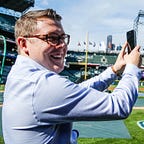Unfinished: Cal Raleigh
Cal Raleigh continues to refine game after monster 2019
Depending on whether you’re more of a MLB Pipeline or Baseball America or Fangraphs person, the Mariners have between five or six of the best 100 prospects in baseball. Catcher Cal Raleigh, for now, is not one of them.
But when you look at the skill-set—and the numbers they produced—that will likely change soon.
“He has above- to well-above average raw power, he has very good strike zone awareness,” GM Jerry Dipoto said, “he has soft hands behind the plate. He grades out as an above-average receiver with an above-average ability to call a game.”
Oh, and he‘s a switch-hitter. Not bad, huh?
Raleigh, 22, was selected in the third round of the 2018 MLB Draft out of Florida State. After reaching a deal with the Mariners in July of 2018 and playing 38 games with the Short-A Everett AquaSox, he played his first full season of professional baseball this past year.
You could say it went alright.
Splitting time between the High-A Modesto Nuts and Double-A Arkansas Travelers, he posted a .251/.323/.497 slash line, good for a .820 OPS. He hit more home runs, 29, than any other Mariners prospect—and any catching prospect in minor league baseball.
“To be honest, I didn’t really know what to expect,” Raleigh said of that first complete season in the Mariners organization. “I don’t know if I really had any goals—it was just going out there and wanting to play and play well. I had a good time and learned a lot from a lot of people.”
And play well, he did. The home run barrage he launched in his final few weeks in the Cal League had fans joking the circuit was now named for him—and not the state in which it resides.
From July 3rd through the 14th, he hit nine home runs in 11 games. It was 15 bombs in his final 24 games in Modesto, before earning the call up to Double-A Arkansas, where he caught a group that was comprised of some of the best pitching prospects in the organization.
And as good as his offense was in 2019, he knows where his priorities as a lie.
“You have to remember, the pitchers come first. Catching comes first,” he said. “That’s my number-one job is taking care of those guys, having good relationships with them.”
That relationship-building should pay dividends going forward.
Raleigh caught, according to MLB Pipeline’s rankings, nine of the organization’s top 16 pitching prospects.
“Cal’s best tool might be his head,” Dipoto said. “His ability to game plan, connect with pitchers and lead a pitching staff is maybe his greatest trait.”
“Cal studies the game. He’s taking notes as it’s going along, and then he’s visiting with the pitcher in that game, constantly going over the lineup, who’s coming up, how they’re going to attack him, how they’re going to use that stuff. His ability to communicate is excellent.”
Andy McKay, Mariners Director of Player Development, echoed that sentiment—praising Raleigh’s ability to manage both sides of the ball.
“It’s really the only position on the field where, defensively, the amount of preparation that goes into that position on a nightly basis is substantial,” McKay said. “He completely embraced that part of the position on top of hitting close to 30 home runs over two levels. It would be hard to say that it could have gone much better in terms of ’19 for Cal.”
So, what’s in store for 2020? Dipoto acknowledged Raleigh, who will play his age-23 season, is “on the radar” as a possibility to see time in Seattle.
Well, technically, he has already seen time in Seattle—as he joined first baseman Evan White and batterymate Logan Gilbert in shadowing the Major League club for the final week of the season, having a locker in the clubhouse, participating in meetings and so on.
The idea is that, come 2020—both for a potential call-up and Major League camp at spring training—they’re familiar with their future teammates, the coaching staff and the day-to-day processes.
“ I’ve been just like a fly-on-the-wall,” Raleigh said during his time in Seattle. “Just watching and observing and taking it in. I haven’t said a whole lot. I want to learn as much as I can. Anytime you get a chance to be around Big Leaguers, it’s a great opportunity to learn.”
“Learning” has been a bit of a theme for Raleigh since his 2019 season ended.
Having left college after his junior season, as nearly all of baseball’s top draft prospects do, he’s spending his offseason returning to Florida State and working towards finishing off his degree in Business Entrepreneurship.
He’s eying spending time with family over the holidays and enjoying some much-deserved downtime. After that, back to work.
“Looking at next year, I just want to improve on everything,” he said. “I want to be a complete hitter. I want to obviously get my arm stronger. A lot of little things.”
It is all about the little things with Raleigh. And, as McKay frequently says, there are no finished products in the game of baseball, whether that’s down on the farm or in the Majors.
“Every aspect of his game can continue to be refined,” McKay said. “He will once again, whatever level you’re at with our system, you’re going to be catching future big leaguers.”
Sooner or later, though—and it may be sooner if his 2020 is anything like his 2019—they won’t be “future” big leaguers that Raleigh is catching.
